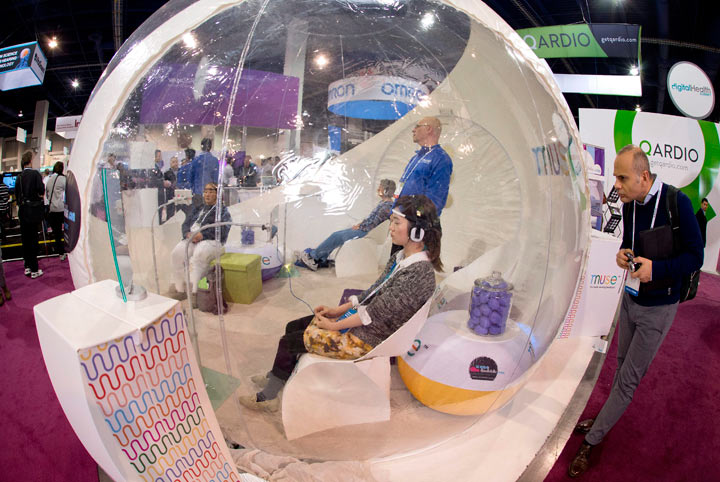TORONTO – A Canadian-made brain-sensing headband called Muse can’t understand your thoughts and feelings or help control your phone or tablet without touch – yet.

But the team at Toronto-based startup company InteraXon, the creators of the new wearable technology product, believes that type of functionality isn’t the stuff of science fiction. It’s coming.
The Muse will soon be shipped out to supporters who placed early orders on the crowdfunding site Indiegogo, where a campaign to raise US$150,000 brought in more than $287,000.
At launch, the US$299 device will be able to measure brain activity and a paired mobile app is designed to help train users to calm their frazzled minds on command.
“(The Muse headband) has seven sensors that read the electrical signals that come out of your brain, those signals are then sent by Bluetooth to a smartphone or tablet and on there we do a bunch of complicated math to sort of tease out signals that tell us meaningful things about what’s happening in your brain,” says Trevor Coleman, co-founder of InteraXon.
“A lot of people worry, ‘Can it read my thoughts?’ but if you think about it like a heart rate monitor, when your heart beats fast you can’t tell if it’s because you just ran a mile or because a pretty girl walked by.”
“But knowing how fast your heart is beating tells you things that helps you exercise better or can help you with all sorts of stuff. In the same way, we can measure general patterns in the brain of how much it’s getting active or calm or things on that sort of level.”
The Muse can only be used with one relaxation app for now. Users close their eyes as they hear the sound of blowing wind and try to calm their mind as much as possible, which in turn causes the breeze to weaken.
Coleman says using the Muse for three minutes a day is like exercising the mind.
“You’re actually developing conscious control over what your mind is doing moment to moment. So even though you train with the headband you learn how to do that skill and you’ll be able to do it even without the headband later,” he says.
“There’s a lot of benefits. The No. 1, I think, is relieving stress and helping you relax, being able to slow your mind down, give yourself a pause and take a break. It’s tremendously helpful.”
Coleman says he expects another app might be ready by year’s end or early 2015. InteraXon has also made a software development kit available so programmers can design their own apps to tap into the Muse.
It probably won’t be long before the technology can better interpret brain activity that’s linked to arousal, pleasure, pain and discomfort, Coleman says.
“That’s definitely the low hanging fruit, we have a researcher who’s here studying that and in laboratories they can do it where they show…whether you like or dislike something, and I think that ideally you’ll be able to sense emotion – that’s not that far off,” he says.
But it is possible that further applications of the technology might require a new headband with sensors placed in different locations
“Whether we can do it with this particular electrode configuration, the sensors being where they are, (is unknown) because your brain is spatially organized,” Coleman says, adding that he expects innovation in the sensors will help InteraXon’s future work as well.
“Right now the sensors we’re using need to contact the skin directly but they’re already working on sensors that can read from a millimetre away or so. That’s about as far as you’ll ever be able to get, because the signals are so low, but it means you could have a baseball cap (with sensors) and then it’s very easy to have sensors all over the head,” he says.
InteraXon is behind schedule on delivering the first Muse units to its Indiegogo supporters, which isn’t uncommon for crowdfunded projects, but the delay has irked some buyers.
“This is an incredibly sensitive technology,” says Coleman in explaining the delay.
“When you look at a brainwave we’re talking about something that’s millionths of a volt – a very, very tiny, tiny signal – and amongst a huge amount of noise from your brain, from the interference of dirt on your skin, the electrical noise from the electrical grid in the world around you.
“So part of it is just getting that stuff to work and it’s baffling even to really huge companies.”


Comments